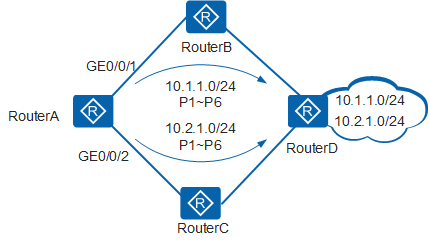Load Balancing and Route Backup
When multiple routes have the same routing protocol preference and metric, these routes are called equal-cost routes, among which load balancing can be implemented. When multiple routes have different routing protocol preferences and metrics, route backup can be implemented among these routes.
Load Balancing
Routers support the multi-route mode, which allows you to configure multiple routes with the same destination and preference. If the destinations and costs of multiple routes discovered by the same routing protocol are the same, load balancing can be performed among the routes.
During load balancing, a router forwards packets based on the packets' 5-tuple (source IP address, destination IP address, source port, destination port, and transmission protocol). When the 5-tuple information is the same, the router always chooses the next-hop address that is the same as the last one to send packets. When the 5-tuple information is different, the router forwards packets over idle paths.
In the example shown in Figure 1, RouterA forwards the first packet P1 to 10.1.1.0/24 through GE0/0/1 and needs to forward subsequent packets to 10.1.1.0/24 and 10.2.1.0/24 respectively. The forwarding process is as follows:
If the 5-tuple information of P2 destined for 10.1.1.0/24 is the same as that of P1 destined for 10.1.1.0/24, RouterA forwards P2 and subsequent packets destined for 10.1.1.0/24 through GE0/0/1.
If the 5-tuple information of P1 destined for 10.2.1.0/24 is different from that of P1 destined for 10.1.1.0/24, RouterA forwards P1 and subsequent packets destined for 10.2.1.0/24 through GE0/0/2.

The number of equal-cost routes for load balancing varies with product models.
Route Backup
Route backup can improve network reliability. You can configure multiple routes to the same destination as required. The route with the highest preference functions as the primary route, and other routes with lower preferences function as backup routes.
A router generally uses the primary route to forward data. When the primary link fails, the primary route becomes inactive. The router selects a backup route with the highest preference to forward data. In this manner, data is switched from the primary route to a backup route. When the primary link recovers, the router selects the primary route to forward data again because the primary route has the highest preference. Data is then switched back from the backup route to the primary route.
